Perovskite Nanocrystal-Coated Inorganic Scintillator-Based Fiber-Optic Gamma-ray Sensor with Higher Light Yields
Abstract
:1. Introduction
2. Materials and Methods
3. Results
3.1. FRET Efficiency
3.2. Photon Counting
3.3. Gamma-ray Spectroscopy
4. Discussion
5. Conclusions
Author Contributions
Funding
Institutional Review Board Statement
Informed Consent Statement
Data Availability Statement
Conflicts of Interest
Abbreviations
| Abbreviation | Meaning |
| FRET | Fluorescence resonance energy transfer. |
| PMMA | Polymethyl methacrylate. |
| QDs | Quantum dots. |
| PMT | Photomultiplier tube. |
| SEM | Scanning electron microscopy. |
| PET | Positron emission tomography. |
| CT | Computed tomography. |
| TEM | Transmission electron microscopy. |
References
- Wang, Z.; Dujardin, C.; Freeman, M.S.; Gehring, A.E.; Hunter, J.F.; Lecoq, P.; Liu, W.; Melcher, C.L.; Morris, C.L.; Nikl, M.; et al. Needs, Trends, and Advances in Scintillators for Radiographic Imaging and Tomography. IEEE Trans. Nucl. Sci. 2023, 70, 1244–1280. [Google Scholar] [CrossRef]
- Enlow, E.; Abbaszadeh, S. State-of-the-art challenges and emerging technologies in radiation detection for nuclear medicine imaging: A review. Front. Phys. 2023, 11, 6546. [Google Scholar] [CrossRef]
- International Atomic Energy Agency (IAEA). Radiation Protection of Children in Radiology. Available online: https://www.iaea.org/resources/rpop/health-professionals/radiology/children (accessed on 25 June 2024).
- Zhang, D.; Li, X.; Xiong, S.; Li, Y.; Sun, X.; An, Z.; Xu, Y.; Zhu, Y.; Peng, W.; Wang, H.; et al. Energy response of GECAM X and gamma-ray detector prototype. Nucl. Instrum. Methods Phys. Res. Sect. A 2018, 921, 8–13. [Google Scholar] [CrossRef]
- Cho, S.; Kim, S.; Kim, J.; Jo, Y.; Ryu, I.; Hong, S.; Lee, J.-J.; Cha, S.; Nam, E.B.; Lee, S.U.; et al. Hybridisation of perovskite nanocrystals with organic molecules for highly efficient liquid scintillators. Light Sci. Appl. 2020, 9, 156. [Google Scholar] [CrossRef] [PubMed]
- Qunatum Solutions. Qdot Perovskite ABX3 Quantum Dots: Technical Data Sheet; Quantum Solutions: Southampton, UK, 2022. [Google Scholar]
- Mohamed, W.A.A.; El-Gawad, H.A.; Mekkey, S.; Galal, H.; Handal, H.; Mousa, H.; Labib, A. Quantum dots synthetization and future prospect applications. Nanotechnol. Rev. 2021, 10, 1926–1940. [Google Scholar] [CrossRef]
- Gidwani, B.; Sahu, V.; Shukla, S.S.; Pandey, R.; Joshi, V.; Jain, V.K.; Vyas, A. Quantum dots: Prospectives toxicity, advances and applications. Deliv. Sci. Technol. 2021, 61, 102308. [Google Scholar] [CrossRef]
- Cotin, G.; Heinrich, B.; Perton, F.; Kiefer, C.; Francius, G.; Mertz, D.; Freis, B.; Pichon, B.; Strub, J.; Cianférani, S.; et al. A Confinement-Driven Nucleation Mechanism of Metal Oxide Nanoparticles Obtained via Thermal Decomposition in Organic Media. Small 2022, 18, e2200414. [Google Scholar] [CrossRef] [PubMed]
- Yang, X.; Xu, T.; Zhu, Y.; Cai, J.; Gu, K.; Zhu, J.; Wang, Y.; Shen, J.; Li, C. Preparation of CsPbBr3@PS composite microspheres with high stability by electrospraying. J. Mater. Chem. C 2018, 6, 7971–7975. [Google Scholar] [CrossRef]
- Song, L.; Guo, X.; Hu, Y.; Lv, Y.; Lin, J.; Liu, Z.; Fan, Y.; Liu, X. Efficient Inorganic Perovskite Light-Emitting Diodes with Polyethylene Glycol Passivated Ultrathin CsPbBr3 Films. J. Phys. Chem. Lett. 2017, 8, 4148–4154. [Google Scholar] [CrossRef] [PubMed]
- Fanizza, E.; Schingo, R.; Panniello, A.; Lanza, A.M.; Depalo, N.; Agostiano, A.; Curri, M.L.; Striccoli, M. CsPbBr3 Nanocrystals-Based Polymer Nanocomposite Films: Effect of Polymer on Spectroscopic Properties and Moisture Tolerance. Energies 2020, 13, 6730. [Google Scholar] [CrossRef]
- Chen, L.-C.; Tien, C.-H.; Tseng, Z.-L.; Dong, Y.-S.; Yang, S. Influence of PMMA on All-Inorganic Halide Perovskite CsPbBr3 Quantum Dots Combined with Polymer Matrix. Materials 2019, 12, 985. [Google Scholar] [CrossRef] [PubMed]
- Děcká, K.; Král, J.; Hájek, F.; Průša, P.; Babin, V.; Mihóková, E.; Čuba, V. Scintillation Response Enhancement in Nanocrystalline Lead Halide Perovskite Thin Films on Scintillating Wafers. Nanomaterials 2021, 12, 14. [Google Scholar] [CrossRef] [PubMed]
- Broussard, J.A.; Green, K.J. Research Techniques Made Simple: Methodology and Applications of Förster Resonance Energy Transfer (FRET) Microscopy. J. Investig. Dermatol. 2017, 137, e185–e191. [Google Scholar] [CrossRef] [PubMed]
- Hamamatsu Photonics K.K. Photomultipier Tubes: Basic and Applications; Hamamatsu Photonics K.K.: Shizuoka, Japan, 2017. [Google Scholar]
- Segre, E. The passage of radiations through matter, Energy Loss of Electrons. In Nuclei and Particles, 2nd ed.; W.A. Benjamin, Inc.: New York, NY, USA, 1964; p. 26. [Google Scholar]
- Knoll, G.F. Interaction of Gamma Rays, Compton Scattering. In Radiation Detection and Measurement, 4th ed.; John Wiley & Sons, Inc.: Hoboken, NJ, USA, 2010; p. 49. [Google Scholar]
- Samedov, V.V. Why Do We Need a Standard Theory of Scintillation Spectrometers with Several Photodetectors? Phys. At. Nucl. 2021, 84, 1713–1728. [Google Scholar] [CrossRef]
- Dorenbos, P.; de Haas, J.T.M.; van Eijk, C.W.E. Non-proportionality in the scintillation response and the energy resolution obtainable with scintillation crystals. IEEE Trans. Nucl. Sci. 1995, 42, 2190–2202. [Google Scholar] [CrossRef]
- Dorenbos, P. Light output and energy resolution of Ce3+-doped scintillators. Nucl. Instrum. Methods Phys. Res. 2002, 486, 208–213. [Google Scholar] [CrossRef]
- Khodyuk, I.V.; Dorenbos, P. Nonproportional response of LaBr3:Ce and LaCl3:Ce scintillators to synchrotron x-ray irradiation. J. Phys. Condens. Matter. 2010, 22, 485402–485408. [Google Scholar] [CrossRef] [PubMed]
- Kuntner, C.; Auffray, E.; Lecoq, P.; Pizzolotto, C.; Schneegans, M. Crystal Clear Collaboration, Intrinsic energy resolution and light output of the Lu0.7Y0.3AP:Ce scintillator. Nucl. Instrum. Methods Phys. Res. 2002, 493, 131–136. [Google Scholar] [CrossRef]
- Birks, J.B. The Theory and Practice of Scintillation Counting, 1st ed.; Pergamon: New York, NY, USA, 1967. [Google Scholar]

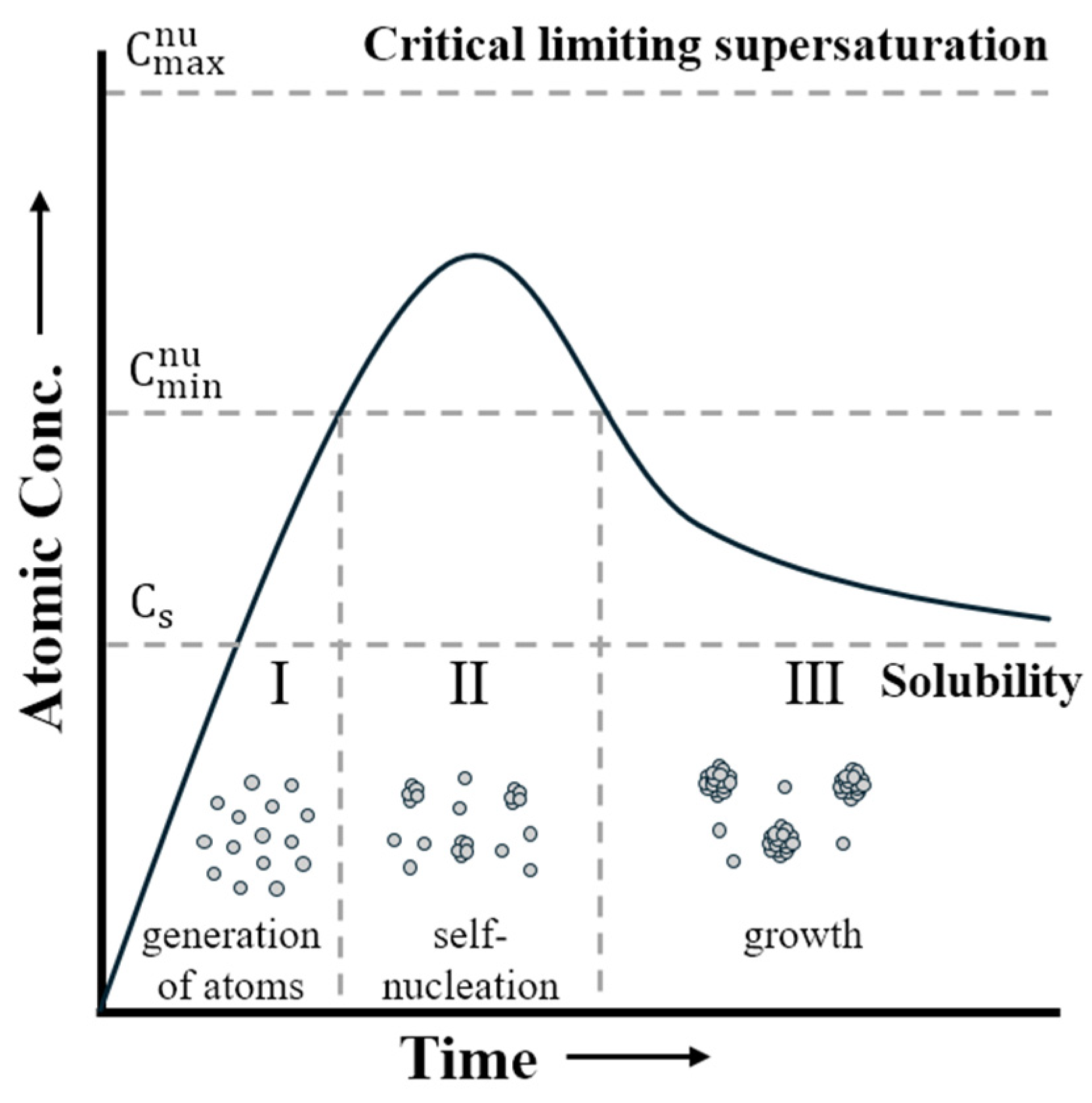
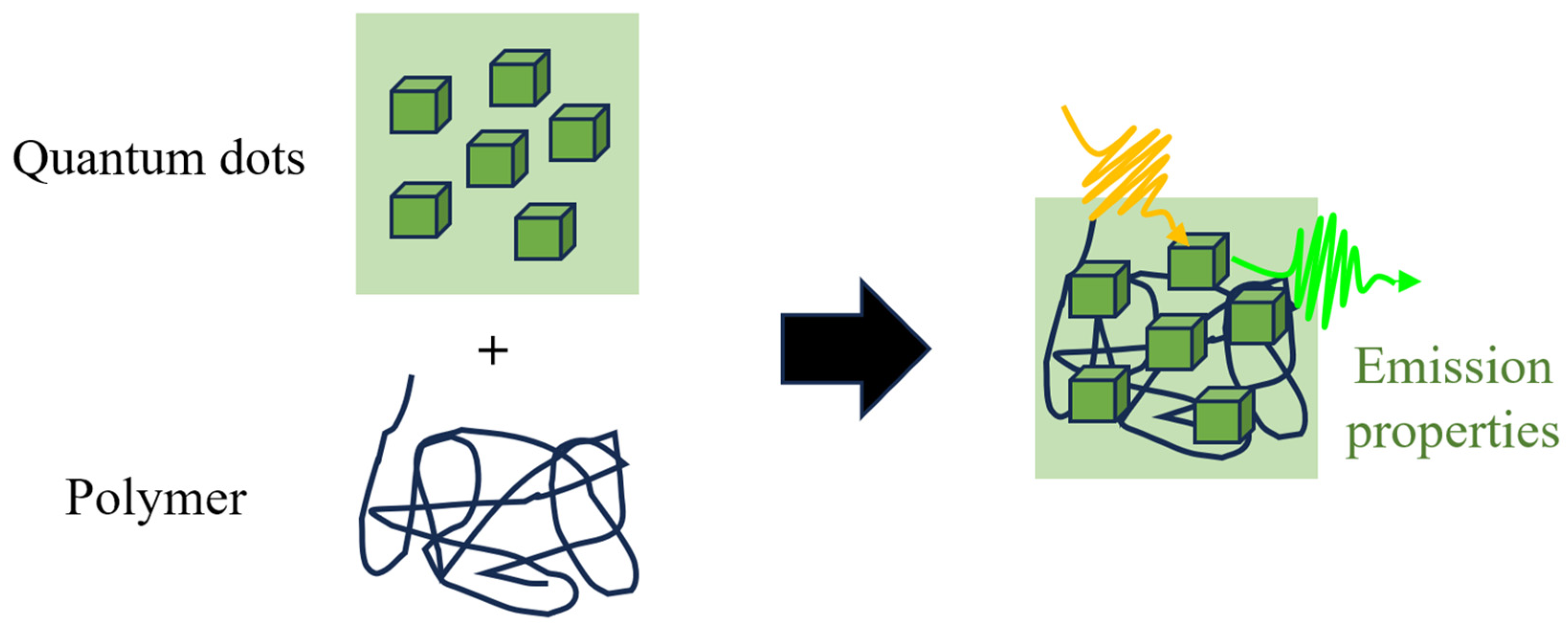



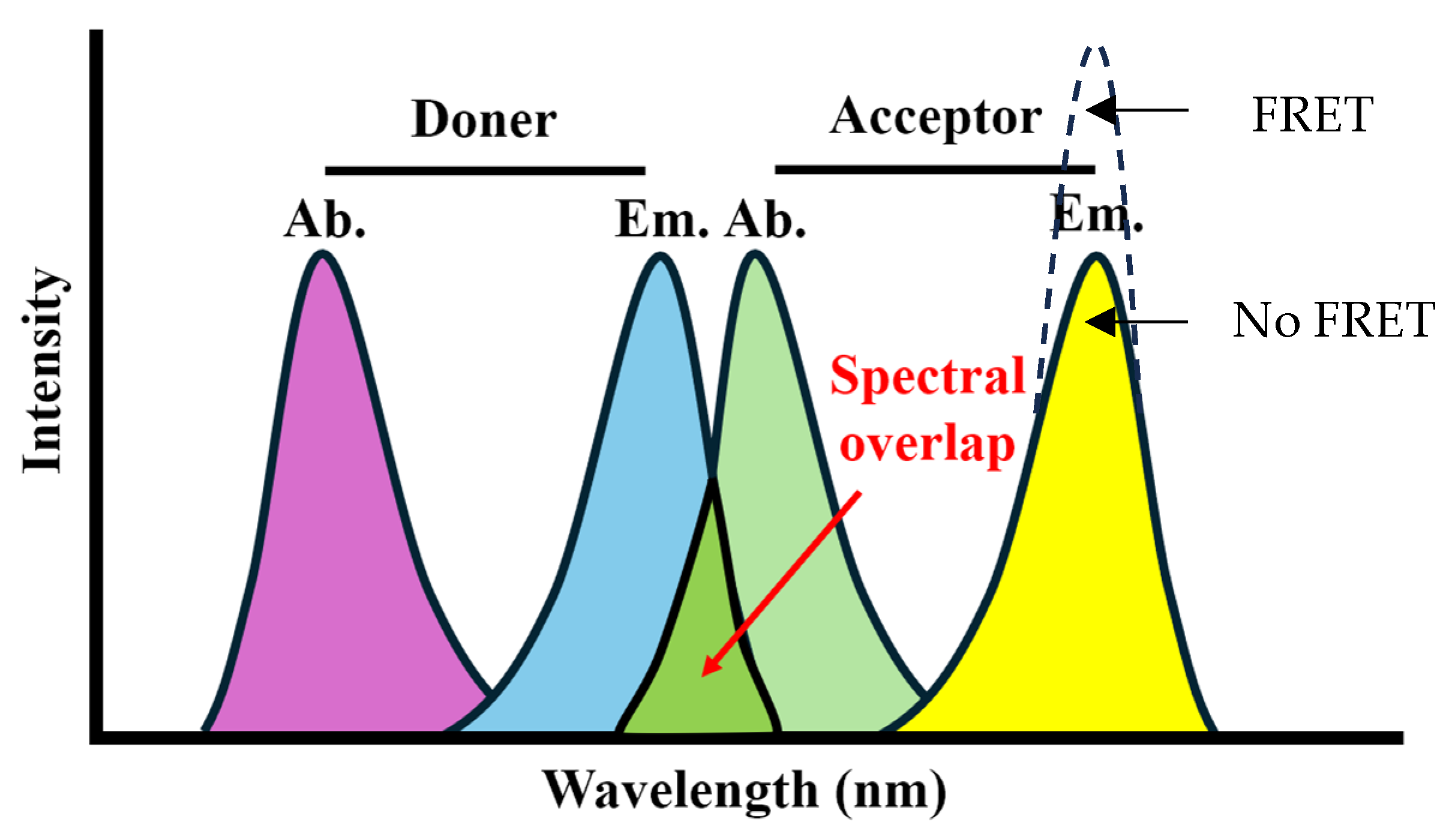
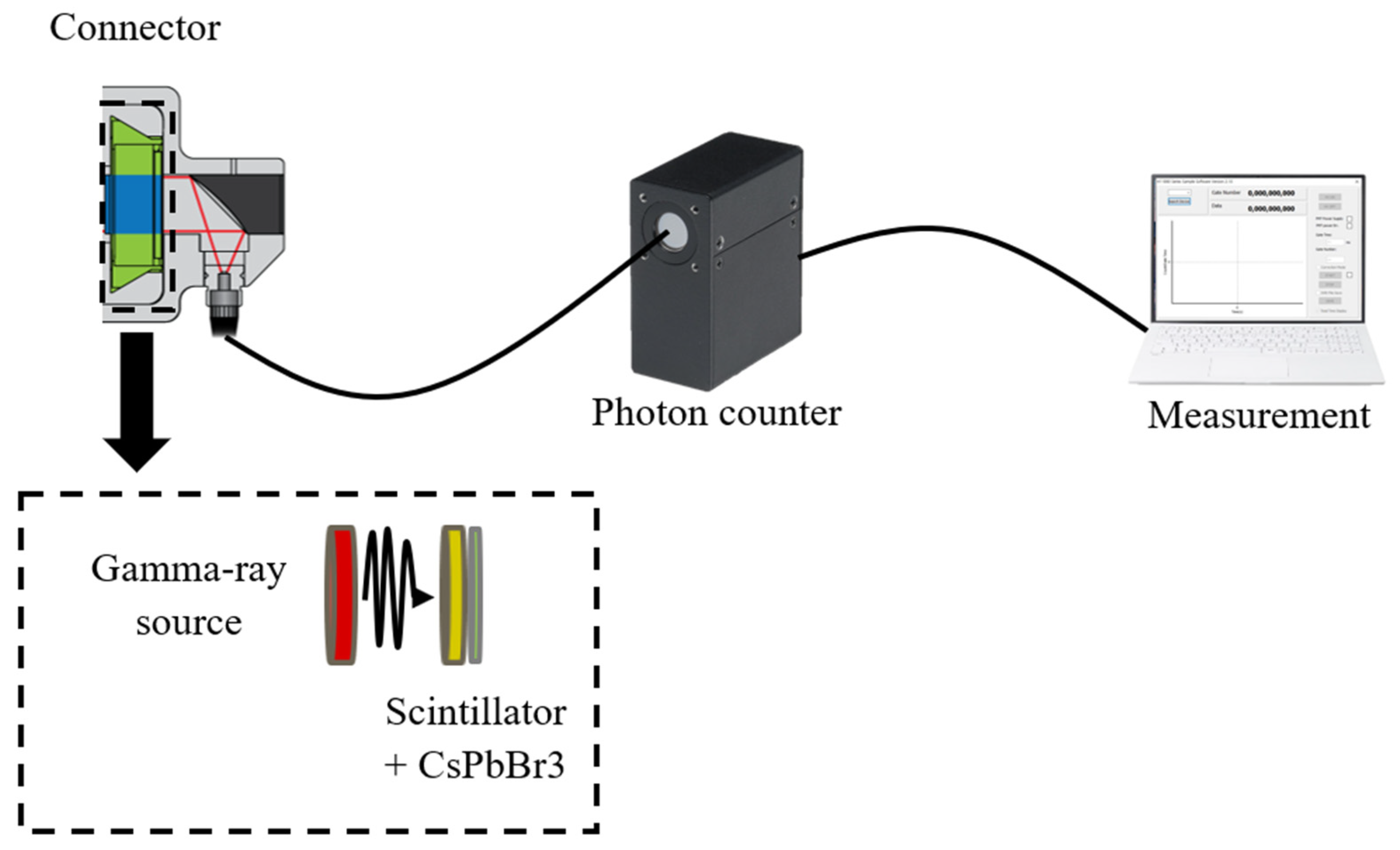

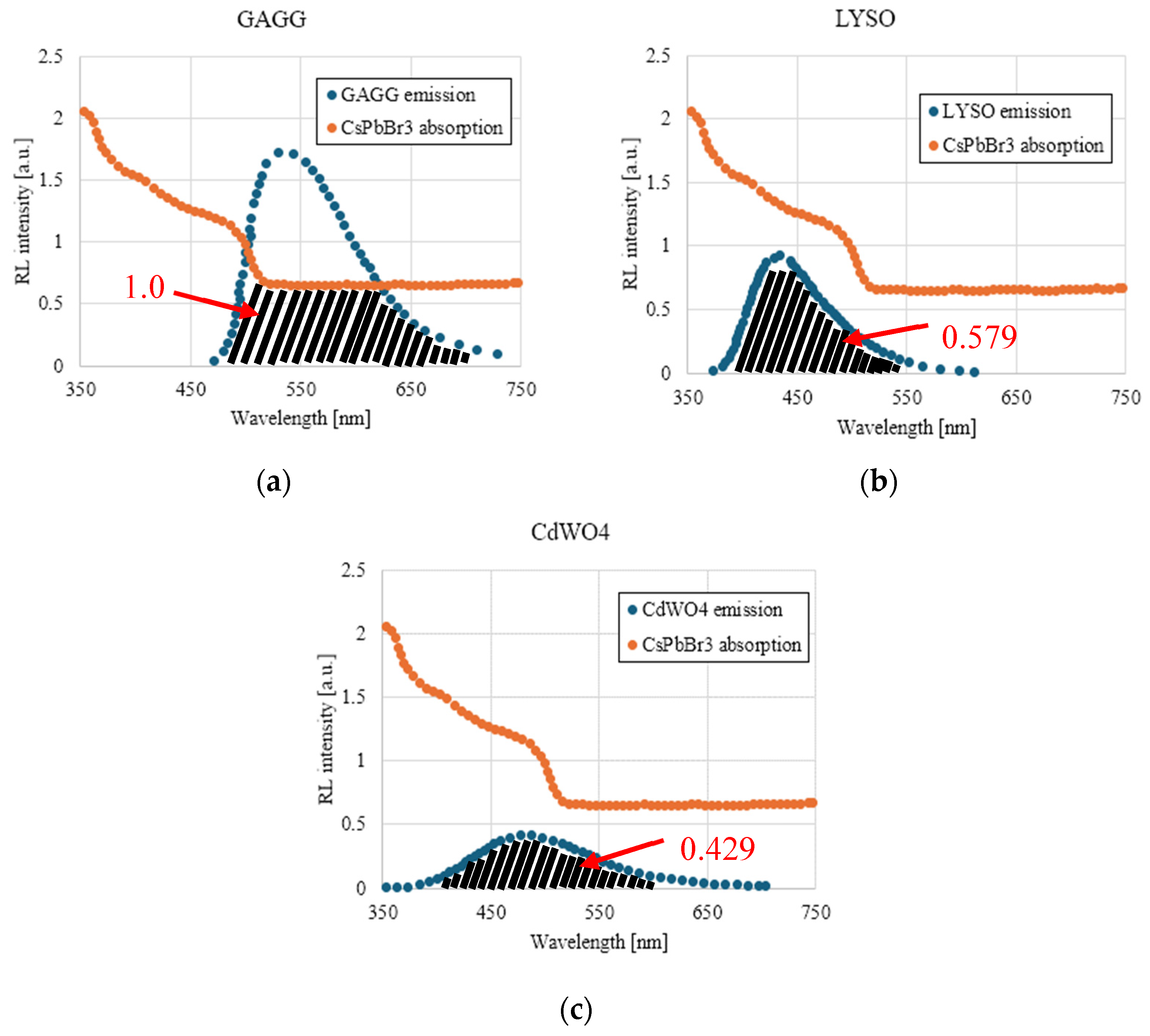
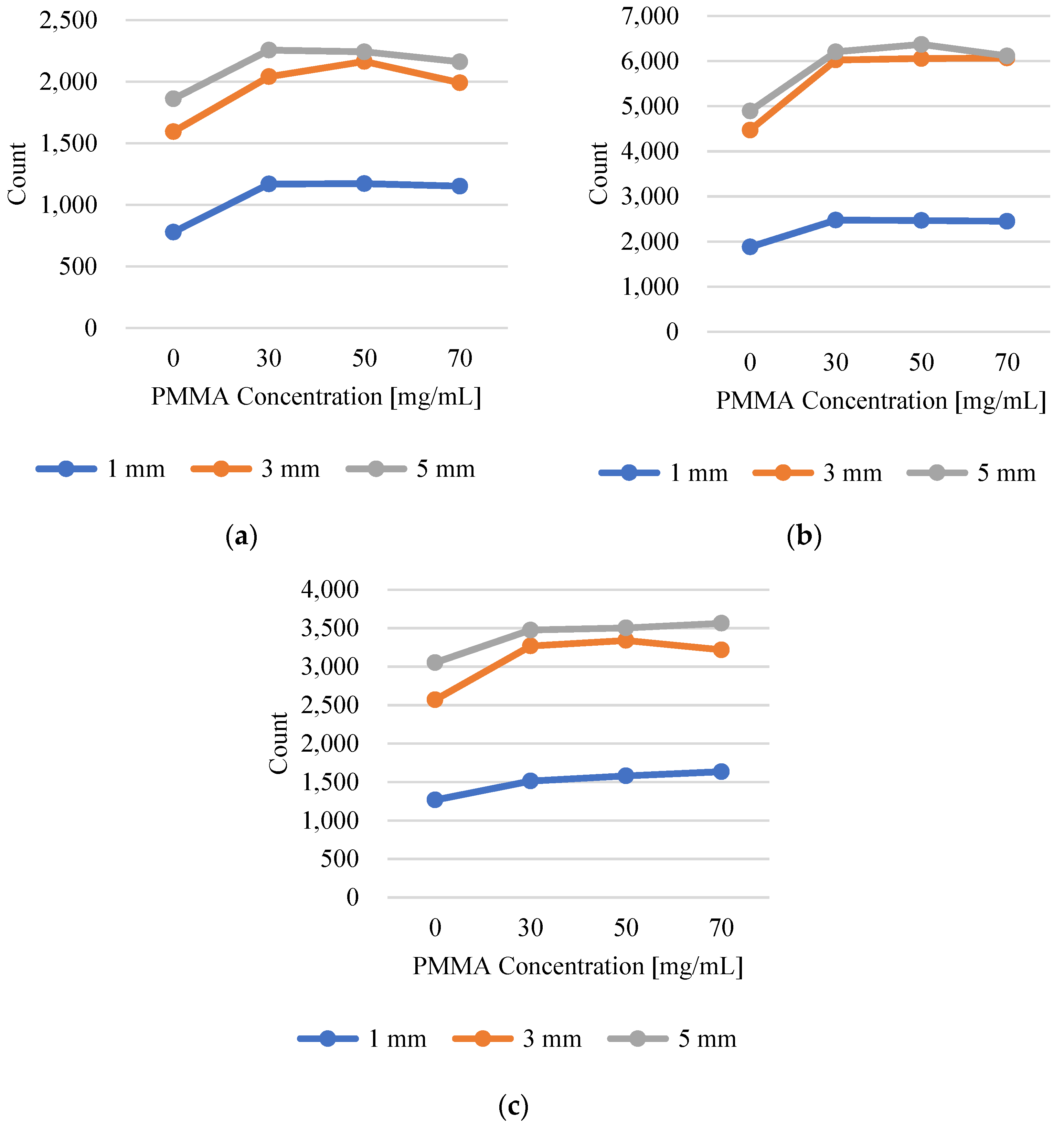



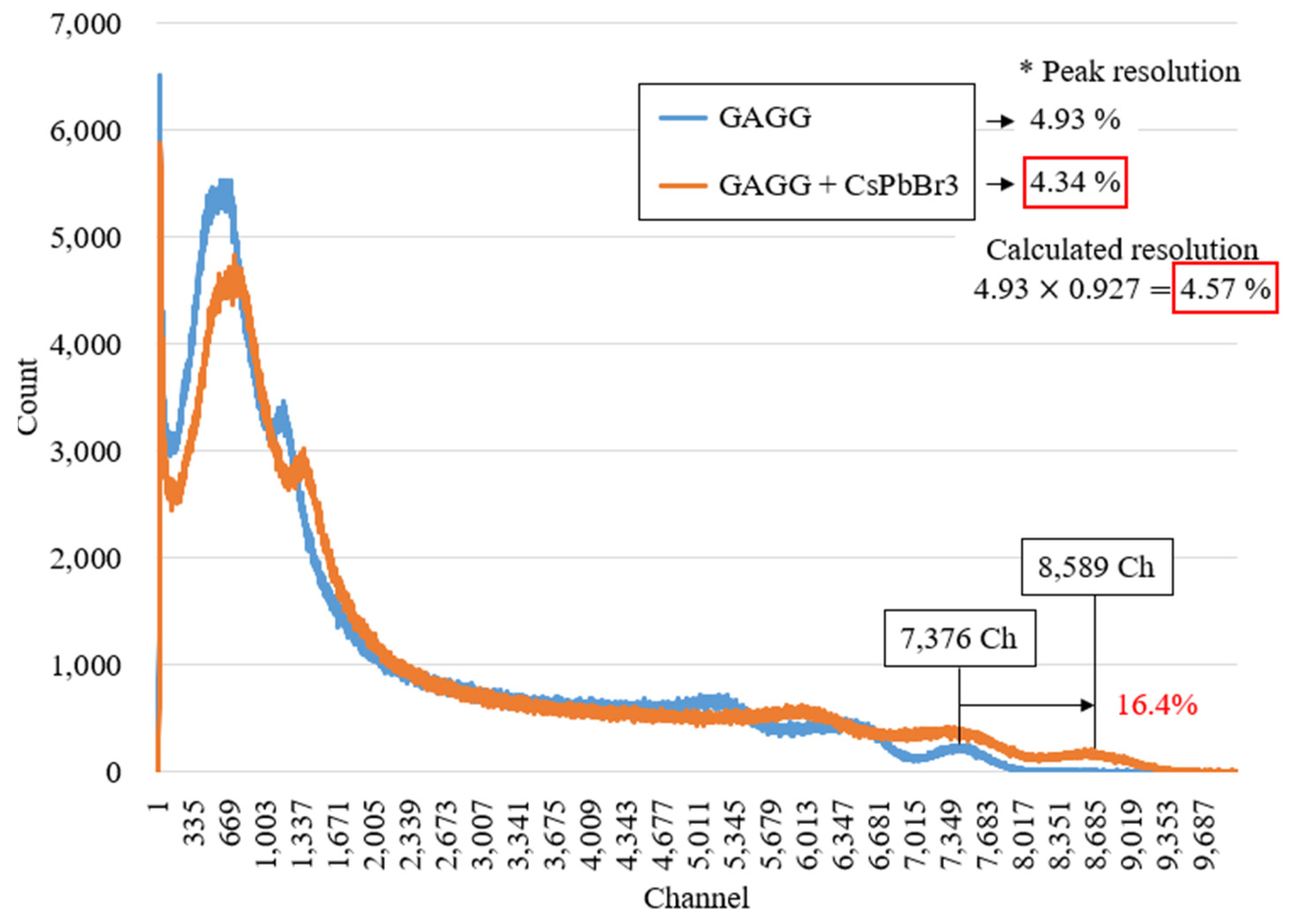

| Core Type | Emission Peak | Average Core Size | Photoluminescence Quantum Yield |
|---|---|---|---|
| CsPb(Cl/Br)3 | 450 ± 5 nm | 7 nm | >60% |
| CsPb(Cl/Br)3 | 480 ± 5 nm | 9 nm | >70% |
| CsPbBr3 | 510 ± 5 nm | 10 nm | >80% |
| Scintillator | Density (g/cm3) | Effective Atomic Number | Light Yield (photons/MeV) | Wavelength of Maximum Emission (nm) |
|---|---|---|---|---|
| GAGG | 6.63 | 54 | 54,000 | 530 |
| LYSO | 7.25 | 65 | 29,000 | 420 |
| CdWO4 | 7.90 | 76 | 13,000 | 475 |
| Scintillator | Gamma-ray Source | Increase Rate (%) | FRET Efficiency |
|---|---|---|---|
| GAGG | Cs-137 | 50.4 | 1.0 |
| Co-60 | 51.6 | ||
| LYSO | Cs-137 | 35.7 | 0.579 |
| Co-60 | 36.9 | ||
| CdWO4 | Cs-137 | 30.0 | 0.429 |
| Co-60 | 32.7 |
Disclaimer/Publisher’s Note: The statements, opinions and data contained in all publications are solely those of the individual author(s) and contributor(s) and not of MDPI and/or the editor(s). MDPI and/or the editor(s) disclaim responsibility for any injury to people or property resulting from any ideas, methods, instructions or products referred to in the content. |
© 2024 by the authors. Licensee MDPI, Basel, Switzerland. This article is an open access article distributed under the terms and conditions of the Creative Commons Attribution (CC BY) license (https://creativecommons.org/licenses/by/4.0/).
Share and Cite
Jegal, S.; Song, S.; Park, J.H.; Kim, J.; Kim, S.; Lee, S.; Pyeon, C.H.; Kim, S.; Lee, B. Perovskite Nanocrystal-Coated Inorganic Scintillator-Based Fiber-Optic Gamma-ray Sensor with Higher Light Yields. Photonics 2024, 11, 936. https://doi.org/10.3390/photonics11100936
Jegal S, Song S, Park JH, Kim J, Kim S, Lee S, Pyeon CH, Kim S, Lee B. Perovskite Nanocrystal-Coated Inorganic Scintillator-Based Fiber-Optic Gamma-ray Sensor with Higher Light Yields. Photonics. 2024; 11(10):936. https://doi.org/10.3390/photonics11100936
Chicago/Turabian StyleJegal, Seokhyeon, Siwon Song, Jae Hyung Park, Jinhong Kim, Seunghyeon Kim, Sangjun Lee, Cheol Ho Pyeon, Sin Kim, and Bongsoo Lee. 2024. "Perovskite Nanocrystal-Coated Inorganic Scintillator-Based Fiber-Optic Gamma-ray Sensor with Higher Light Yields" Photonics 11, no. 10: 936. https://doi.org/10.3390/photonics11100936





